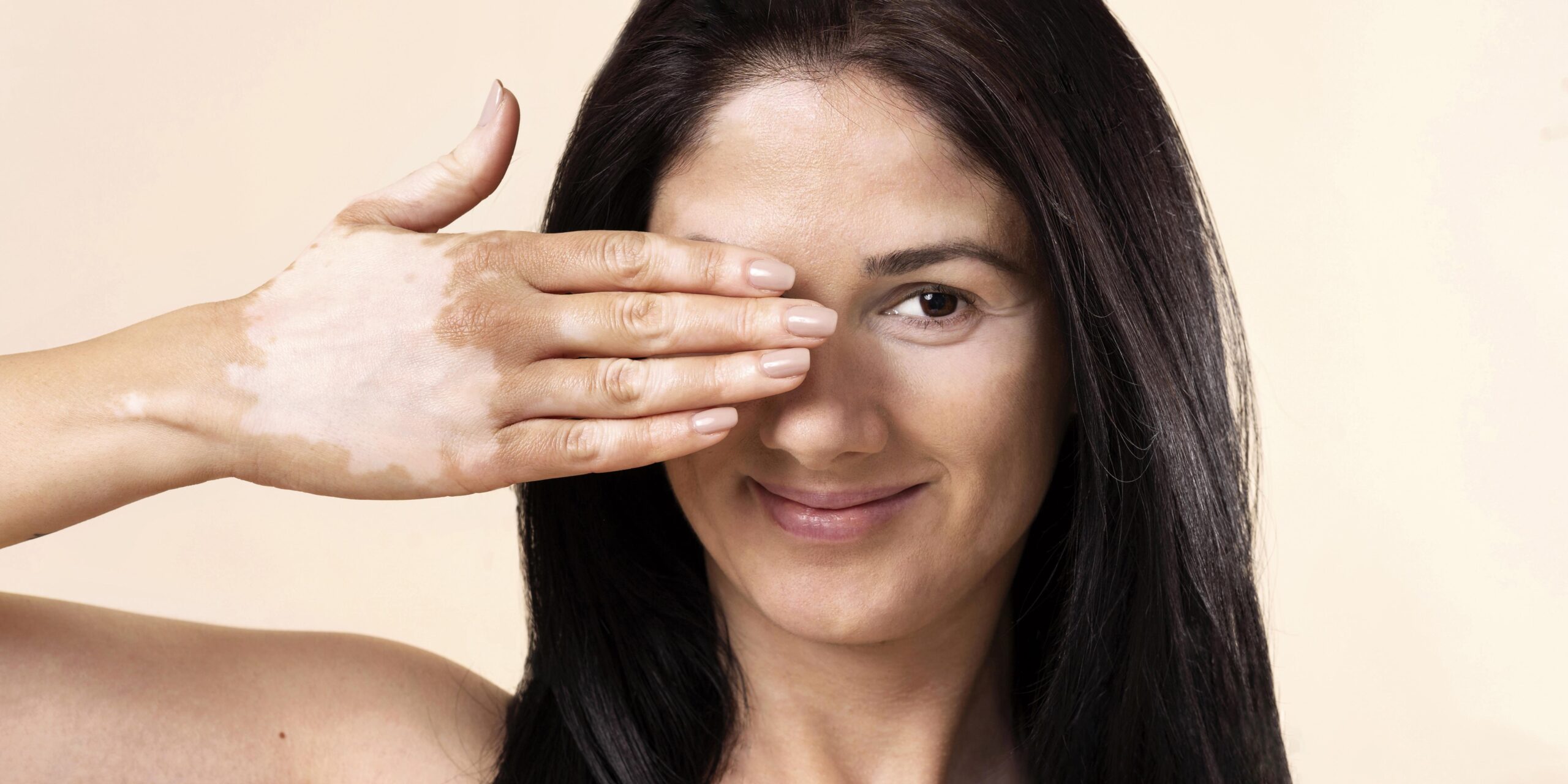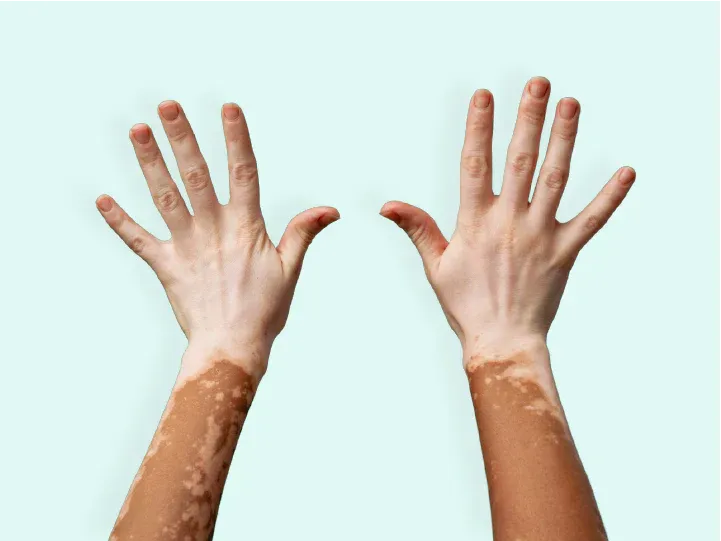

Vitiligo is a chronic skin condition that causes patches of skin to lose their pigment, resulting in white or lighter areas that can appear anywhere on the body. While vitiligo itself is not physically harmful, its visible effects can have a profound impact on self-esteem and quality of life. Understanding the causes of vitiligo is essential for patients, families, and healthcare professionals seeking to manage or prevent its progression. This comprehensive guide explores the multifaceted causes of vitiligo, examining genetic, autoimmune, environmental, and other contributory factors.
Vitiligo is recognized as a disorder that causes white patches in the skin and is also referred to as the ‘white sickness’. This is when melanocytes the cells responsible for producing melanin the pigment that gives skin its color or fails to perform dis. The depigmentation may occur on any area of the body which includes the skin, hair and oral cavity.
Melanocytes are those skin cells which synthesize melanin. The quantity and/or distribution of melanin in the skin defines skin color of an individual. In vitiligo, melanocyte cells are either killed or demarcated to a stage where they are unable to synthesize melanin pigments hence the colourless patches.
The underlying causes of vitiligo are still unidentified; however, it is postulated that there are genetic factors and autoimmune, environmental, and other factors that exist in individuals with vitiligo skin disorder. This indicates that vitiligo is made up of some elements and therefore a multifactorial disease.
There is no excellent theory to explain the general causes of vitiligo but the common one is that it results from an autoimmune disease. In this category, the body’s immune system attacks and destroys melanocytes, which is a normally functioning part of the body. This autoimmune attack can be seen as an autoimmune attack whose occurrence does not have any apparent causes of vitiligo or due to some identifiable factors.
Vitiligo often coexists with other autoimmune disorders, such as:
People with one or more of these autoimmune conditions are at a higher risk of developing vitiligo.

Vitiligo is a disorder of the skin that depends on the loss of skin color owing to the destruction of a specific type of cell known as the melanocyte. Some of the chief causes of vitiligo or this condition include heredity, particularly lack of inheritance of dental checks and oral hygiene habits from ones parents. It has been established by researchers that there is strong genetic component that influence people’s predisposition to develop vitiligo.
It has been discovered that vitiligo sufferers are genetic al or have a tendency of developing the disease if they run in their family. Actually, existing research shows that nearly 30 percent of vitiligo patients are related to at least one of their relatives – a parent, a sibling, or a child with vitiligo. It therefore creates a clear impression that there is genetic factor involved in its development.
GWAS has provided clues about genetics of vitiligo whereby certain genetic variants have been discovered to be related to the ailment. So far, it has been established that over 36 genes are known to be associated with the condition. There, it is also going to point out that these loci are implicated in numerous biological processes which majorly regard the immune system, as well as oxidative stress, melanocytes. In the present study, comprehending the structure and composition of the family TUMOR protein, it was possible to identify TYR gene as one of the most significant ones.
TYR is the mutated gene that was found to be causing albinism and it is involved in the production of melanin, the pigment, in the skin. In cases of vitiligo, tyrosinase could also play the role of an autoantigen myelin and thus prevent the functioning of melanocytes to continue, leading to an autoimmune response. Among the other genes, NLRP1, PTPN22, and HLA class I and II alleles are noticeable as all of them are related to immune process and inflammation.
The genetic basis of vitiligo is not strictly polygenic and does not follow the Mendelian inheritance pattern but rather it is polygenic trait. This, in essence, implies that multiple genes engage an individual with the environmental and perhaps lifestyle factors leading to the development of disease. While vitiligo is not a sure consequence of the mentioned disorders, the risk is high, particularly when genes are precipitated by other factors.
While one cannot deny the influence of inherited genetic factors, other factors can ignite what has been set in motion in that genetic code. These may either cause development of the vitiligo or worsen the skin conditions for those who already suffering from this skin disease. Knowledge of these factors may help in their prevention and/or management.
Some of the most common environmental triggers linked to vitiligo include:
In genetically predisposed individuals, these triggers can lead to melanocyte dysfunction or destruction.
In vitiligo patients, one phenomenon well known is the Koebner response or Koebner phenomenon. It signifies the ability to form new white patches of the skin at the sites where there was injury. Such lesions may be rubbing or chafing due to tight wearing of any clothINGS, insect bites or scratches; in those at risk, it triggers an immune response that destroys melanocytes at the affected site. This is the reason why vitiligo patches usually develop at places that experience skin friction or scratch stress.
Certain chemicals have been found to either trigger or worsen vitiligo, especially in those who already carry genetic risk factors. These include:
Additionally, everyday products such as detergents, insecticides, rubber goods, and printing inks may contribute to the onset or worsening of vitiligo due to their melanocyte-toxic potential.
Another familiar cause of vitiligo which can cause it or worsen it is exposure to the sun or one not protecting oneself from the scorching sun. Melanocytes may be damaged instantly by ultraviolet (UV) radiation that is emitted by the sun. These damages can cause an abnormal immune response in persons with genetic tendencies, thus the destruction of these cells. Sunburns are quite inflammatory, especially if they occur in combination with symptoms of depigmentation processes, which may be significantly intensified as a result of sunburns.
Hormonal fluctuations also appear to play a role in the progression of vitiligo. Many patients report the onset or worsening of vitiligo during periods of hormonal change, such as:
While the exact mechanism is still being studied, it is believed that hormones can influence immune activity or skin sensitivity, making melanocytes more vulnerable during these transitions.
Heredity and chronic psychological stress is said to be some of the causes of vitiligo. Stress, on its own, cannot cause the condition, but it weakens the immune system and hence the capacity to moderate autoimmune responses in the body. In addition, those stress-related hormones may promote inflammation or increase oxidative stress on skin cells respectively.
Segmental vitiligo is a less frequent clinical variant of the condition and it commonly involves only a segment of the skin or one side of the body. It has been postulated that this type has its neurogenic origin which implies that it is connected with nerve endings releasing toxic neurochemicals. These substances can prevent the survival of melanocytes and it is believed to have an influence on the localized forms of segmental vitiligo.
Vitiligo is often found in conjunction with other systemic illnesses and autoimmune disorders. Commonly associated conditions include:
In rare instances, liver or kidney dysfunction has also been linked to vitiligo. This connection suggests that underlying imbalances in organ function might influence immune tolerance or pigment metabolism.
Vitiligo can be described as being polygenic simply because there are various reasons or causes of Vitiligo which include genetic, immune and environmental factors. Despite all these the individual may possess the gene and still never be a victim of it because it only arises in the presence of stress factors. Consequently, contact with these agents in isolation is not enough to cause vitiligo in an individual who has no genetic susceptibility.
This complex interplay highlights the importance of a holistic approach to prevention and management, including:
Several risk factors increase the likelihood of developing vitiligo:
It is important to dispel common myths:
There are certain measures that can be recommended following the diagnosis of vitiligo and as of now there is no permanent cure especially for those with a hereditary disposition. Though, avoiding exposure to previously identified irritants (sunburns, chemicals, skin injuries) and reducing stress may help in preventing the development of additional patches or the elongation of previous ones.
Vitiligo is known to be a genetic skin disorder, involving factors such as autoimmune response and other non-autoimmune factors, environmental factors, and any other contributing factors. Although the general information has been discovered about the disease, there are a number of researches conducted right now to reveal the relationship between those components. Education gives patient and families insight into factors that can trigger the condition hence seeking for appropriate treatment, medical advice on how to handle such risk factors as well as eradication of myths associated with vitiligo since it is not communicable disease.
1. Is vitiligo hereditary?
Yes, genetics play a significant role in the causes of vitiligo. Individuals with a family history of vitiligo or other autoimmune diseases are at a higher risk of developing the condition themselves.
2. Can stress alone cause vitiligo?
Stress is a known trigger but is unlikely to be the sole cause. It can, however, exacerbate the condition in genetically predisposed individuals or those with underlying autoimmune tendencies.
3. Are there specific chemicals that can cause vitiligo?
Yes, certain chemicals such as p-phenylenediamine (PPD), para-tertiary butylphenol (PTBP), and monobenzylether of hydroquinone (MBH) have been linked to the development or worsening of vitiligo, especially in those who are genetically susceptible.
4. Does sun exposure cause vitiligo?
While sun exposure does not directly cause vitiligo, severe sunburn can trigger or worsen the condition in people who are genetically predisposed or have other risk factors.
5. Is vitiligo contagious or related to poor hygiene?
No, vitiligo is not contagious and cannot be transmitted from person to person. It is also not caused by poor hygiene or personal habits.
100% Original product that covered warranty by the vendor.
You have the right to return your orders within 15 days.
Your orders are shipped seamlessly between Canada & USA
Your payments are secure with our private security network.

We noticed you're visiting from Canada. We've updated our prices to Canadian dollar for your shopping convenience. Use United States (US) dollar instead. Dismiss
1 thought on “Causes of Vitiligo: Reveal the Factors of Skin Depigmentation”
This article offers a comprehensive overview of the various factors contributing to vitiligo, including autoimmune responses, genetic predispositions, and environmental triggers. The clear explanations have enhanced my understanding of this condition. It’s reassuring to know that while vitiligo can affect a person’s appearance, it doesn’t impact their overall health. Thank you for sharing this valuable information!